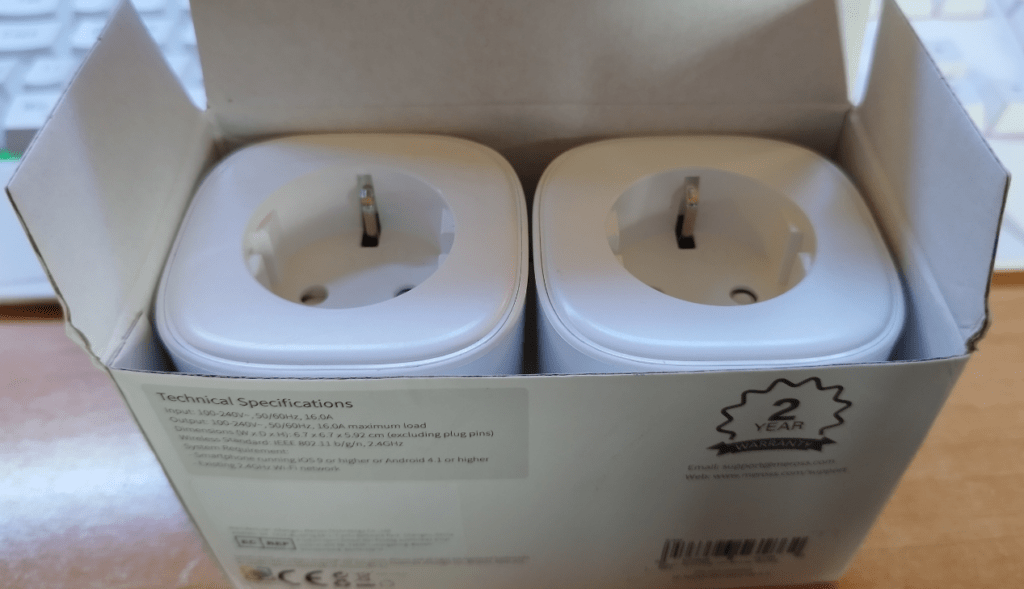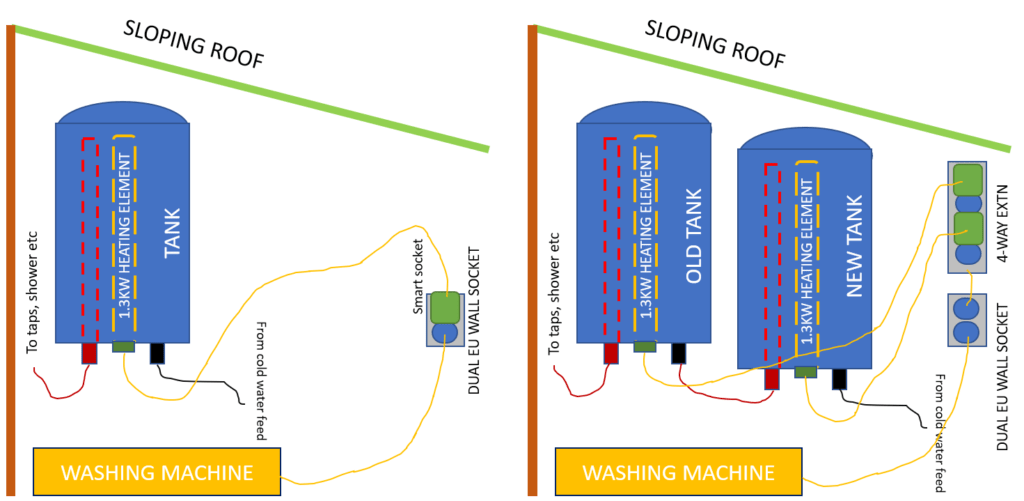April 2022 Update – Meross MSS310 EU Version and my Twin Hot Water Tanks
All change. I am now predominently based in Spain. I just received a pair of the EU versions of the MSS310 plug (in one box – sold as a pair) and like the UK version they worked out of the box – I did have to set my phone initially to the auto-generated local access point on the plug so I could tell it about my WiFi – simple. I have to say, reliable up to now, yes, solid-looking – yes, but they tend to take over 3 sockets on an extension unless you have 2-pin plugs on either side.
I do wish Smart plug manufacturers would shrink their plugs – as it stands there’s a potential here for only getting two Meross sockets and nothing else on a 4-way extension and they are not alone in this. Like it’s UK counterpart, the EU MSS310 has full power monitoring and of course works with the Meross APP (but not Tasmota).

My devices are hardware version 6.0 and firmware version 6.1.10 – but it is not at first obvious how to update the firmware. Oh, well, the APP at the top says “New Firmware available” – let’s go look… erm, no – the device is apparently up to date. The notice was referring to another Meross device not currently plugged in. There’s a nice, green button on the top face (photo – to the upper right) which does manual on-off and if kept pressed doubles up as a pairing button – not needed here as I was running this plug for the first time.
So, overall, large, not visually exciting but they look adequate and with power handling of up to 16A (non-inductive I’d suggest) they’re beefy anough for small heaters. The plugs do of course work with Alexa and Google Assistant.
And now on April 24, 2022, I have an actual use for these – I’ve just bought a second hot water tank as the dishwasher room isn’t big enough to bin the existing hot water tank but IS big enough to take a second tank so the two are side by side.
The point of this is that our little 80 litre tank is just big enough for the two of us but we have guests coming soon so we need that extra capacity on demand. The new heater arrived in a box with, would you believe, no instructions and without the KW consumption printed on the box – I could not believe it.
So, I plumbed the two tanks so the hot-out of the first one connected to the cold-in of the second – the idea being that we can leave the first tank switched off normally and have it come on when we have guests, the hottest water rising to the top of the second tank (which feeds out hot water). I wanted to know how much power each was taking and happily had those two Meross units to hand. I can of course measure the instantaneous wattage for each tank as well as keeping a history of what they use. This is working a treat but that takes me back to an earlier point.
There is no way I can fit the two Meross units side by side using my 2-way Spanish power wall outlet due to the sheer size of the Meross units (most smartplugs have the same issue). So, against my better judgement, I’ll have to put them on an extension… BUT having tested each tank with the Meross units and now knowing the tanks only take 1.3KW – and knowing that Spanish cheapest rate electricity runs from midnight until 8am (and all weekend), I believe I can safely run these two on an extension, giving say, the first tank two hours at midnight, then the second tank 2 hours at 2am, back to #1 at 4am, #2 at 6am (and leaving power to the second tank off when I’m home alone).
That way I’m only using 1.3KW on the extension at any time and by the look of it I can adequately heat the water in that overnight timespan. By looking at the power history I should know whether either needed the full 2 hours each time – hopefully on the 4am and 6am slots I’ll be using less than 100% on-time, proving my point.
If anyone thinks I’ve done this completely the wrong way, feel free to comment. I should say the setup has already passed the wife test – 24 hours later…. Now, don’t all rush in and say “but you could have used Sonoffs” – this way if I drop down dead, all she has to do is remove the timers 🙂
Update May 2022
I’m quite happy with the Meross plugs despite not working entirely off-grid. I have two of them (as above) operating the two hot water tanks and keeping track of electricity use, so I thought it sensible to add another of the same type for the washing machine in the same room as that also uses a fair bit of power. Brand new MSS310 out of the box.. asks if the green and orange lights are flashing – yes. Connect? Yes… my phone asked me to connect to the local Meross plug access point to start the ball rolling – I was two slow due to writing this update at the same time, so the phone made the change itself – connected. Typically the default name for these devices is “living room lamp” so it asked me to rename the device – I did – “washing mc”. Did I want to change the icon? No. Did I want to change WIFI? Yes. Done. The next job would be the timer… in the APP under SMART – I added 4 new ROUTINES i.e. a new pair of on an off times – for this device only – every weekday midnight to 2am and again 24 hours over the weekend – easy.




Great info, thanks. In case it helps others, I bought a Meross MSS420F from Amazon https://www.amazon.co.uk/Meross-Outlets-Compatible-Assistant-Control/dp/B07NXSTQV8 and replaced the wifi controller with an ESP-12F with tasmota on it. The only things required were a pull-up on CH_PD(CHIP_EN) and a wire connection from ADC to GPIO16. With that, these were the settings to get tasmota operating all 4 sockets:
GPIO4 = LED
GPIO12 = relay2
GPIO13 = relay1
GPIO15 = relay3
ADC = relay4 – can’t be an output therefore bridge wire to GPIO16
GPIO14 = button
WELL, I don’t know about others – but if I can dig out my old supply of ESP12Fs…. I could see me doing the same thing. The Meross outlets are nice and reliable but like others I’m prone to preferring having such units using Tasmota – impossible with non-ESP-based controllers. Hmm, food for thought. Good one, Bruce.
Hi Pete, not sure where in Spain you are, but don’t you have a solar water heater? We’re in Greece at 35 degrees north, where the hot water tanks sit on the roof and are combined with solar. They are well insulated and have an internal 3.5kW electric element, but we only have to use it in December and January, maybe a bit of February. An ESP32 / Tasmota on the roof is currently reporting 160 litres of water at 62C, which rises to a scary 65-70 in mid-summer. Ds18B20’s are measuring HW, and panel top/bottom temperatures. We have to tell guests to be careful! Also pleased to say we don’t have radiators any more…. a modern heat pump cools in summer and warms in the (short) winter.
Hi Chris – solar hot water heaters (in fact anything that isn’t edible or drinkable) is quite expensive in Spain (yes, so much sun, you would think solar would be dirt cheap – it’s not).
Years ago I was tempted by a couple who lived (live) on the coast who said they needed no electric for hot water from April to November…This year has proven that’s not necessarily the case. We’ve just had snow here in Granada region – and rain – with just the odd sunny day – and we’ve more rain to come… also I’m reserving roof space for a new solar hot water panel we got cheaply second hand – for our pool. Hopefully this time next month we should be able to start using it to heat the pool which is currently typically sitting at 10c or so.
Hi Pete,
Shelly has also a thermostatic valve. https://shop.shelly.cloud/shelly-trv-wifi-smart-home-automation#597 – I use 6 of them in my house and works like a charm. They use researchable LIPO, so you don’t have to replace batteries, just charge them once a year.
I must say they LOOK neat – but as I no longer have radiators – not a lot of point in grabbing one to test. I’ll have radiators in our new place back in the UK but I don’t plan to be there for some time – also I’ve never really been a fan of measuring temperature at the source – seems to me the other end of the room might make more sense. But clearly they work for you. What’s a researchable LIPO ? Was that meant to be rechargeable? 🙂
Sorry, rechargeable LIPO.
The shelly software installed on TRV allow to receive a remote sensor temperature via http or mqtt. I use sonoff ZigBee temperature sensor and wrote rules in Tasmota’s sonoff zigbee to wifi gateway to forward received temperature to TRV mqtt channel. TRV’s and temperature sensors are useful to maintain in each room the desired temperature. You can configure TRV to connect to local mqtt server, not to shelly cloud.
With regard to the radiator thermostat it will be interesting to know how they perform for range and battery life – I’ve tried similar in the past and both were poor – I think being stuck onto a large sheet of metal (the radiator) is probably the limiting factor. I now use a mains powered actuator such as the one I have linked below along with a sonoff basic and a ds18b20 along with your node red thermostat program and I get individual control for every room via mqtt and full Alexa voice control and because it is under my control I can adjust the settings to outside temperatures and forecasts . In addition because the Sonoff and the ds18b20 are some way from the radiator I get good signal range and accurate room temperature rather than radiator temperature as you get with TRV’s. Total cost well under £10 per room.
https://www.aliexpress.com/item/4000443454659.html?uttaskid=552049&utcontentid=5951&utalgorithmid=2&tracelog=rowan&rowan_id1=eclc_en_ord_3_1_en_US_2020-02-26&rowan_msg_id=stevUTT_552049_0_$483a0508376749d8a21ed50c6d222b8a&ck=in_edm_other
Agree battery life needs testing. Rang too but recent RF stuff I’ve has has been better than in days of old, not much but a little. Having said that, we bought a new Air Source heating system end of 2018 and the first thing I did was to bin the RF portable thermostat which used RF in favour of my own dual SSID WIFI version.
Yup I am with you all the way here though I would never actually RELY on Alexa and I’m sure you don’t. MQTT over WIFI hsa been rock solid for me – along with Node-Red Dashboard (not the prettiest but it works).
Steve, that is very interesting that you are having success with UFH manifold actuators. I had proposed that they might work on radiators on Peter’s blog some time ago and more recently suggested them as an option to a particular issue Peter had. I have not had time to try them myself but based on your post I will in the near future. The price of the items you linked is good too, if one can get anything out of China these days! I don’t even know if BG and Ali are even shipping anything.
they are, but probably from different locations as before, as many items are now with shipment fees…